![]() "Down this way, boys"
"Down this way, boys"![]()
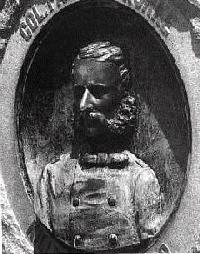
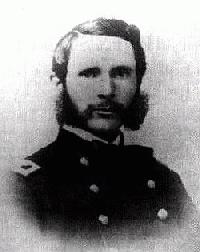
Patrick "Paddy" O'Rorke - Killed July 2, 1863
The 140th New York On Little Round Top
![]() Addendum to "The
Supreme Event in its Existence: The 140th N.Y. on Little Round Top" written by the
author to clarify and expand this article.
Addendum to "The
Supreme Event in its Existence: The 140th N.Y. on Little Round Top" written by the
author to clarify and expand this article.
Brian A. Bennett lives in Wheatland, New York about 10 miles southwest of Rochester. He has received BFA and MFA degrees in graphic design from the Rochester Institute of Technology. He is currently employed as the director of publications at the State University of New York College at Geneseo.
Mr. Bennett is a member of the 140th N.Y.Y.I. Living History Organization. This group was responsible for the purchase, design and erection of a monument to the 140th New York on the Wilderness battlefield. The monument was dedicated in May, 1989, and he delivered a speech on the unit's actions in the battle. He has been researching the 140th for about five years and has just begun writing a regimental history, using mostly unpublished material similar to what was used for this article.
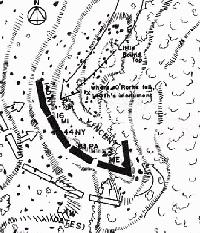
From almost anywhere south of the town of Gettysburg it is visible-the rocky face of Little Round Top. A trip to its summit reveals a panoramic view of such well-known sites as Devil's Den and the Wheatfield. Like most of the battlefield, there is an abundant harvest of monuments on the crest. One sits in memory of the 140th New York Infantry, and from the monument juts the bronze relief of a man-Col. Patrick H. O'Rorke, killed July 2, 1863. Situated in the shadow of the 44th New York "castle," the 140th's memorial tells little about O'Rorke and his men.
Born in troubled Ireland, Paddy O'Rorke had immigrated to America as a boy, becoming a resident of Rochester, New York. At the age of 21 he entered the United States Military Academy, when most men his age were graduating. But O'Rorke had kept busy during those "lost" years, learning the stonecutter's trade. When he graduated from West Point in 1861, it was at the top of his class. (At the bottom of the same class was George Armstrong Custer.) O'Rorke served as a staff officer early in the war, seeing action at First Bull Run (Manassas), then on the Carolina and Georgia coasts.1 In September 1862 he was offered command of a new regiment being raised in Rochester, the 140th New York. It was conceded that O'Rorke had a great future as a leader. As a prominent writer summed him up: "[O'Rorke was] as mild as a May morning, his manner and voice those of a quiet refined gentleman."2
Shortly after being mustered, the 140th New York became part of the V Corps, Army of the Potomac, brigaded with regulars. Between the solid influence of professional soldiers and O'Rorke's own West Point sense of duty, the 140th quickly became a well-drilled and highly-disciplined group of volunteers. Upon the rocky slope of Little Round Top, the 27-year-old O'Rorke and his men would be tested in the fire of combat.
The regiment had been under fire at Fredericksburg and at Chancellorsville, where O'Rorke had temporary brigade command. But neither battle could be classified as heavy combat for the regiment, and on the eve of Gettysburg the 140th could be considered a regiment yet to prove its mettle.
On the slopes of Little Round Top, late in the afternoon of July 2, O'Rorke and his men were given the opportunity. What the 140th and other Federal regiments did on Little Round Top has been the subject of numerous studies, most notably Oliver W. Norton's The Attack and Defense of Little Round Top. Despite extensive analysis, the part played in the fighting by the 140th has been undercut by the lack of a definitive account of its action. As the story has been passed along, other inaccuracies have been added, until, like so many other stories, what is truth and what is fiction become blurred.
The standard account of the action is well-known to students of Gettysburg. Briefly told, on the second day the brigade of Strong Vincent, consisting of the 20th Maine, 83rd Pennsylvania, 44th New York and 16th Michigan, was heavily engaged on the southern slopes of Little Round Top. The Confederates under Maj. Gen. John B. Hood pressured both flanks; on the left, Joshua Chamberlain and the 20th Maine repelled the attacks, but on the right, the 16th Michigan was in trouble.
Brig. Gen. Gouverneur K. Warren, on the scene, quickly cast about for more troops. Coming upon the 140th New York, moving as reinforcements for the Wheatfield, he immediately sent them up the slope of Little Round Top. Reaching the summit, the 140th's commander, Col. Patrick O'Rorke, dismounted and led his men down the southern slope to bolster the 16th Michigan. O'Rorke was killed instantly by a bullet through the neck. The 140th swung into line next to Vincent's brigade and helped to end the last real threat to Little Round Top.
Few of the numerous Gettysburg accounts have attempted an in-depth description of the tactics used by 140th on July 2, 1863. The major problem has been the lack of writings by members of the 140th, including the absence of a regimental history. The most useful reminiscences (and the ones most quoted) were written by Porter Farley, acting adjutant of the 140th at Gettysburg and later captain, before receiving a disability discharge in the summer of 1864.Farley left two accounts of the 140th's action on Little Round Top. One was his "Number 9," which appeared verbatim in Attack and Defense, the cryptic title indicating the article was the ninth in a series of 17 for a Rochester newspaper during the late 1870s. The second account is the speech Farley delivered at the 1889 dedication of his regiment's monument on Little Round Top. The accuracy of Farley's accounts is not in doubt; they were based on letters and a journal kept by Farley during the war. Oliver Norton critiques Farley's "Number 9" thus: "I see nothing to criticise in his account. . . . It is the simple story of an intelligent soldier who was present in the battle, and related what he saw and heard." 3
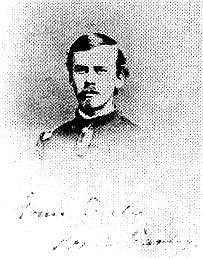
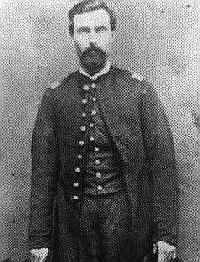
Porter Farley and Henry Cribben
Ironically (probably because of the fact that he only reported on what he saw first-hand), Farley's account does not describe how the 140th men did what they did. In terms of military tactics, he is vague in his description of what happened. Despite the overall length of "No. 9," the decisive action is reported as follows:
O'Rorke shouted, "Down this way, boys!" and following him we rushed down the rocky slope with all the same moral effect upon the rebels, who saw us coming, as if our bayonets had been fixed and we ready to charge upon them. Coming abreast of Vincent's brigade, and taking advantage of such shelter as the huge rocks lying about there afforded, the men loaded and fired, and in less time than it takes to write it the onslaught of the rebels was fairly checked, and in a few minutes the woods in front of us were cleared except of the dead and wounded. 4
There are three other published postwar accounts by members of the 140th. Two appeared as articles in The National Tribune, a national newspaper written for and by Civil War veterans. One account was by Joseph Leeper, captain of Company E at Gettysburg, published in the April 30, 1885, issue. The other article, from the September 13, 1894, issue, was written by Samuel R. Hazen, who fought at Gettysburg as a private in Company G. The obvious shortfall in these accounts, however, is that they were written 22 and 31 years after the fact.
The third postwar source is the The Military Memoirs of Captain Henry Cribben. Published in 1911 by his widow, this thin volume deals principally with Cribben's capture and subsequent escape from a Confederate prison in 1864. A compilation of talks he gave to veterans' groups, it does contain a section on Gettysburg, unfortunately riddled with inaccuracies.
In evaluating the accounts with known facts, Farley's appears to be the most reliable. Hazen's account reads very well and contains only one proveable, minor inaccuracy. Leeper's and Cribben's not only contain inaccuracies, but are tinged with the self-created drama inherent in many war stories.
Were it not for the recent discovery of four letters written by eyewitnesses just after the battle, the detailed actions of the 140th New York on Little Round Top would remain a mystery. Three of these were written July 3, 1863, while the fourth was written August 12, 1863. All the writers were members of the 140th and participants in the battle.
All the letters, except for the one from "True Blue," were written to family members, who in turn offered the accounts to the local newspapers for publication.
As with most accounts of Civil War combat, not one of the four can be called a definitive version. But by applying what is already known from other regimental sources, an examination of the ground on which the 140th fought, and the newly-discovered letters, a reasonable theory on the military tactics used by the regiment can be developed.
Some basics are already known. The strength of the regiment at that time was 526 men. The companies were roughly equal in size, because the regiment had received 76 transfers from the 13th New York on June 24. Farley wrote that these transfers "were so apportioned as to equalize as much as possible the strength of our companies."5
The 140th was part of Weed's brigade of the V Corps, originally designated as reinforcements in the Wheatfield. The 140th was moving along the Wheatfield Road when Warren came down from Little Round Top in search of more troops
. Any accounts that mention it, state that the regiment was a column of fours, right to front. After quickly discussing the situation with Warren, O'Rorke turned the head of the column to the left and started up what Farley described as the "wooded, rocky eastern slope of the hill."6 Farley stated this meeting between Warren and O'Rorke took place while crossing the slight ridge north of Little Round Top, about "where the railroad now crosses the roadway".7
A park map of Gettysburg, circa 1905, shows the path of what was then known as the Gettysburg Electric Railway, a trolley route that ran through the battlefield. The intersection of the railway and the road appears to be just about at the intersection of the two park roads today. In moving up Little Round Top the 140th would have followed the general route of the park road that exists today, moving diagonally across the slope to reach the peak of the hill (west of today's parking area).
The 140th began to ascend Little Round Top, moving across its northern face in a southwesterly direction. To understand the actions of the regiment, it is important to look at the lay of the hill and the position of Strong Vincent's brigade.
Little Round Top's crest is long and narrow and runs in a north-south axis. The northern-most edge of the crest is near the statue of General Warren. The highest point on the hill is occupied by monuments to the 91st Pennsylvania and Hazlett's battery. Moving south, the crest slopes down, marked by the paved pathway that ends by the monuments of the 44th and 140th New York.
Just below the 44th's tower is a flat shelf where the monument and flank markers for the 16th Michigan are located. The topography here is quite agreeable for regiments facing south, as Vincent's were. This shelf narrows and grows less level as it follows the contour of the hill around its western face, but could still accommodate a battle line.
Farley's version of the story has the 140th scrambling to the top of Little Round Top and immediately moving down the slope to bolster the outflanked line of the 16th Michigan. But three of the four soldier letters mention a deployment in line of battle upon reaching the crest followed by the dividing of the regiment into two parts.
Unknown member of Co. F: "We took a position ... on the brow of a hill and so open to sharpshooters that our loss was very severe, we were on the left wing and remained on the hill. But the right wing went below, and being exposed to severe cross fires were terribly cut up."8
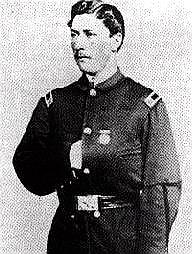
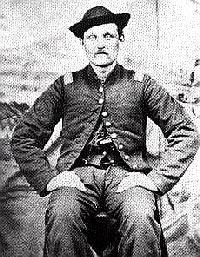
James Rennick Campbell and Hugh McGraw
Cpl. James Campbell, Co. D: "We reached there [top of Little Round Top) just in time to front them, and show them the muzzles of our guns. . . . Gen. Warren then called out to Colonel O'Rorke to bring his regiment to the front of a ledge of rocks, and to cut off the last regiment."9
"True Blue," Co. K: "Arriving at the top, we discovered the Rebs ascending the south side of the hill in solid columns. Our Colonel immediately moved us forward, he himself leading the way-descending the south and west side, towards which the enemy were advancing. The hill is covered with large rocks, which gave our men great protection. We had not been long in position when it was discovered that the Rebs were getting the best of us on the south side. The Colonel now moved the right wing of the regiment to that point."10
From the above, it appears that the regiment's first movement upon reaching the top of Little Round Top was to form in a line of battle. The New Yorkers arrived in a column of fours, right in front, and in order to form a battle line in the correct orientation, they would have had to perform the maneuver known as "on the right, by files into line". This movement, ponderous enough on a level parade ground, would have been further hampered by the uneven ground and boulders of Little Round Top. A much quicker maneuver would have been to have the regiment "front" into a battle line, and then about-face, moving the rear-rank file-closers out of the way. Captain Leeper of Co. E remembers O'Rorke's initial command on the crest as being "Face to the rear; forward, follow me."11
In reference of the contours of Little Round Top, it is important to note that from where the 140th crested the hill,its men could not see Vincent's line. In more than one account, members of the 140th implied they were on the scene before Vincent's brigade. Reaching the crest, O'Rorke, with no specific orders, would have only been able to see Confederates swarming over and around Devil's Den. Logically his first move would have been to get his regiment in a line of battle, facing the visible enemy. This line would probably have followed the north-south orientation of Little Round Top's crest.
It is not clear how long it took before O'Rorke became aware of the pressure on Vincent's right flank, the 16th Michigan. However, the word came, and O'Rorke faced the problem of having to rebuild the part of the 16th Michigan's line that was gone, and also bolster that flank against Confederates approaching up the western slope of the hill.
The 16th Michigan had eight companies in line that day, numbering about 150 men. At some point a mistaken order resulted in the color guard and three companies falling out of line. (Lt. Col. Norval Welch, commander of the 16th, estimated that 48 men left the line).12 Another 59 Michigan men fell in the battle, and most of these casualties had likely occurred by that time. So, in all, there were probably about 50 men left on the 16th Michigan's line, one that had been originally held by 150.
It can be assumed that the withdrawal of parts of the 16th had already occurred, as one witness from the 140th wrote that the Confederates were in the process of "flanking the 44th N.Y."13 With the colors off the line, there was no way for members of the 140th to tell that it was the 16th Michigan they were reinforcing.
The arithmetic was simple. The 140th, with an average company size of about 50, would need two companies to reform the right end of the 16th's original line. Hazen, a member of Co. G, specified the lead companies: "He [O'Rorke] was in front of the two leading companies (A and G.) We followed close to him down the slope and nearly direct toward Big Round Top." Hazen's statement is doubly revealing, as he also described the direction of the movement: "nearly direct toward Big Round Top.''14
Hazen's account also gives another important detail in revealing that he helped a wounded member of the 16th Michigan. This incident occurred after the initial contact and corroborates the position of Co. G as having been next to the 16th Michigan.
If Company A were the lead company, but G ended up next to the 16th, O'Rorke must have taken only those two companies-not the entire right wing-down the slope. The maneuver "by companies into line" is the simplest evolution that would result in the positions of Cos. A and G. This deployment of two companies would have provided the number of men sufficient for reforming the right of the 16th Michigan.
Local lore holds that the 140th's monument sits near the spot where O'Rorke was shot, implying that the colonel fell before reaching the shelf the 140th was moving to reinforce.15 One of the eyewitnesses sheds some light on this confusion with the following lines: "Our Colonel was in front of us with his sword drawn, cheering us on. We had not gone far before he fell, shot dead. We soon got our position, when we opened on them. They soon fell back, our boys being too much for them; but they did cut us down dreadfully while we were advancing."16
This account implies O'Rorke was shot before reaching his objective, and that the men of the 140th continued past his body to their position. Therefore, the belief that the 140th's monument sits where O'Rorke was shot is given credibility.
It is not clear if O'Rorke specifically asked for two companies. Those who were within earshot recalled nothing beyond O'Rorke calling out to the head of his regiment to move down the hill. It may be that the captains of Cos. A and G, Milo Starks and Perry Sibley, were the only company commanders within hearing distance and therefore moved immediately.
The advance of Cos. A and G down the slope has sometimes been described as a charge with fixed bayonets. It can be more accurately described as a deployment under fire. As to the use of bayonets, none of the accounts specifically addresses their presence or absence. The only implication was made by Farley, when he wrote: "We rushed down the rocky slope with all the same moral effect upon the rebels, who saw us coming, as if our bayonets had been fixed and we ready to charge upon them."17
The newly-discovered accounts also put into question whether or not the men had time to load their rifle-muskets before being deployed. Farley's two accounts lend credence to the belief that the regiment did not have loaded muskets. In his 1889 dedication speech he said: "This is the truth of the matter: that as the regiment came over the ridge its muskets were empty, and its leading companies rushed down the hill to meet the enemy without firing a shot. It was only when you came abreast of the men of Vincent's Brigade near the foot of the hill that you had time to load and return the fire which spit a deadly fusillade from the woods before you."18
James R. Campbell, Co. D, writing on July 3, 1863, however, related that:
We reached there [top of Little Round Top) just in time to front them, and show them the muzzles of our guns. But here was a sad mistake committed. Our Generals did not take the precaution to have our men load before we came into the contest, and so we were delayed a few moments in loading. Gen. Warren then called out to Colonel O'Rorke to bring his regiment to the front of a ledge of rocks. . . . It was about this time that Col. O'Rorke, cheering on his men and acting as he always does, like a brave and good man, fell, pierced through the neck by a Rebel bullet.19
Samuel Hazen, Co. G, also suggested the rifle-muskets were already loaded:
We followed close to him [O'Rorke) and nearly direct toward Big Round Top. When within 40 feet of the enemy Col. O'Rorke turned around and said: "Here they are, men. Commence firing." Those were his last words, as he was shot immediately after by a Johnny distant about 40 feet, and that was johnny's last shot, for a number of Companies A and G fired instantly.20
In a sense, it may be moot whether or not Cos. A and G had loaded their weapons. Coming down the slope in a rough column, the men would not have been able to fire as a unit until swinging into a battle line. Either way it can be said that the men came down the slope under enemy fire and were unable to return fire until forming in a line of battle. It is likely the remaining eight companies would have loaded while at the top of the hill, before coming down as reinforcements.
That the death of O'Rorke caused some confusion is made evident by the apparent delay in the deployment by the remainder of the regiment. "True Blue" (Co. K) wrote: "It was not known by the officers or men of the left wing that the right wing had been deployed, so thick were the rocks on the hill.-The Rebs were now retreating, and the left wing descending the hill following the enemy, but were halted about the centre of the hill."21
From a position facing west on the crest of Little Round Top, the remaining eight companies of the 140th would merely have had to come down the hill to bolster the right flank of the line. This portion of the line took a position along the western face of Little Round Top, conforming to the shelf.
Henry Cribben, at the time a first sergeant in Co. F, was the only participant to describe the shape of the regiment's line, saying that "one-half of the regiment faced the Devil's Den and the other half faced Round Top."22 While it seems more likely that two companies faced Round Top and eight faced west (Houck's Ridge/Devil's Den), Cribben is describing a v-shaped line.
The accompanying diagram shows the probable deployment of the 140th. The order of companies given in the diagram is not established, except for the knowledge that A and G were the two lead companies. A casualty list sent to a Rochester newspaper by a member of the 140th listed the companies in the following order: A, G, E, H, F, B, D, C, 1, and K.23 This correctly gives A and G as the lead companies, and by examining the number of casualties in each company (given in diagram), this formation would be a strong possibility. Co. G took the most casualties as it deployed under the fire the remnant of the 16th Michigan was receiving. Co. A took the heaviest losses in dead and Co. E in wounded; as part of the salient of the line, they were exposed to a cross fire. Cos. I and K suffered light casualties and would have logically been on the extreme right of the line, away from where most of the major fighting occurred.
As an aside: one detail that has been an item of some contention is what style uniform the 140th wore at Gettysburg. The notion that the 140th wore its Zouave uniforms at Gettysburg is an easy mistake to make. The only two easily accessible accounts, the regimental history of the 146th New York, with which the 140th was brigaded, and Joseph Leeper's National Tribune article, both put the 140th in Zouave uniforms.
But there is a larger body of information that points to January 1864 as the date the 140th received Zouave uniforms. Several letters from members of the unit describe the acquisition of the uniform. In a letter to a Rochester newspaper dated January 8, 1864, under a headline including the notation "The 140th N.Y.V. Turned into a Zouave Regiment-New Uniform and a Pretty Good One," Private Joseph Moon describes the occasion:
It has been rumored a long time that the 140th was to have a Zouave uniform, and yesterday the expectation was realized by the arrival of several wagons loaded with large dry goods boxes. The boxes were opened at once, and behold there appeared the prettiest and best uniform in the army . . .the color dark blue, trimmed with red. The pants are the bag style, gathered at the waist and knees, and a pair of leather and cloth leggins from the knees to the ankles. A short jacket-made to represent jacket and vest together-red trimmings on the breast, and bound with the same color. A blue sash around the waist, bound with red. The cap is red, with large blue tassle and white turban. The shirt is of plain red flannel .24
Porter Farley, in his reminiscences, also marks January 1864 as the time when Zouave uniforms were issued to the 140th. Unfortunately his account was heavily edited for publication (Rochester in the Civil War, Rochester Historical Society Publications Vol. 22) and that section was not included. The 155th Pennsylvania's regimental history (Under the Maltese Cross) states that they also received their Zouave uniforms at the same time, January 1864. There seems to be little doubt that the 140th was not wearing Zouave uniforms at Gettysburg.
Studying the preceding information, a strong case can be made for the following scenario of the 140th New York's defense of Little Round Top: Marching in a column of fours, right company (Co. A) in front, the 140th Weed's brigade, V Corps, is moving west on Wheatfield Road. General Warren suddenly appears coming down the slope of Little Round Top to the regiment's left, shouting for reinforcements. After a brief consultation with O'Rorke, Warren details his aide, Capt. Chauncey B. Reese, to lead the 140th up the hill. As the regiment climbs the hill, part of Hazlett's battery, 5th U.S. Artillery, passes through the strung-out line of the 140th.
At the head of his column, O'Rorke reaches the summit of Little Round Top and quickly tries to survey the situation. He is unable to see Vincent's brigade from his position at the northern crest of the hill, but sees smoke and hears musketry from the southern slope. He spurs his horse and moves along the crest to get a better idea of what is happening. Upon reaching the southern crest of Little Round Top he views the 16th Michigan, on the right flank of Vincent's line, crumbling under a cross fire of heavy musketry on the front and right flank.
Behind O'Rorke, the rest of the regiment has reached the top of the hill. Bullets fill the air, fire probably meant for the men of Hazlett's battery, part of which is already on the hill. Lt. Col. Louis Ernst, Maj. Isaiah Force, and the company commanders form the men in battle line by having them front, and then about-face, moving the file-closers out of the way. This leaves the line facing the only enemy visible: the Confederates at Devil's Den and along Houck's Ridge. Some captains, on their own initiative, have their companies begin to load.
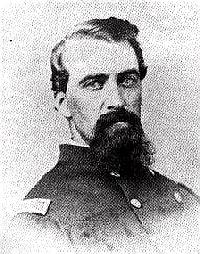
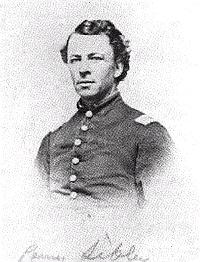
Milo Starks and Perry Sibley
O'Rorke returns to the regiment and dismounting, calls out to the head of the column, "Down this way, boys!". With his sword drawn, he heads across the summit of the hill towards the position of Vincent's brigade. Capt. Milo Starks follows him with Co. A. Capt. Perry Sibley is behind Starks with Co. G.
Before going down Little Round Top's southern slope, where part of the 16th Michigan is giving ground, O'Rorke turns back to check the progress of his men. Here, visible to the enemy, he is shot through the neck and falls without a sound. Starks and his company rush past the fallen O'Rorke, unable to fire because of their column formation.
Captain Starks will receive four wounds that day, but stays with his company. It is not clear how many bullets hit him as he came down the slope. As his men scramble down the steep slope to the shelf, he calls out "By company into line," and the men file to the right of the disintegrating 16th Michigan. Co. G, led by Captain Sibley, also wounded that day, performs the same maneuver and files in alongside the left of Co. A, and in contact with the right of the 16th Michigan.
Under fire the entire movement, the two companies finally deploy into a battle line. Those who are shouldering loaded rifle-muskets immediately open fire; the rest load and fire at will.
Co. E, behind Co. G, stays on the crest because its captain sees no room for his men between Co. G and the 16th Michigan. There is confusion and hesitation, owing to O'Rorke's death and the regiment's jumbled lines. Cos. A and G are caught in a cross-fire that the 16th Michigan was enduring on its front and flank. Colonel Ernst, who had commanded the regiment at Chancellorsville while O'Rorke was an acting brigadier, shouts out for the remaining eight companies to remain in a battle line, but to move obliquely to the left and connect with Cos. A and G.
Co. E forms on the right of Co. A, but at a rough right angle, as the position lies where the hill begins to curve back to the north. Co. E deploys in the deadly cross fire and suffers heavy casualties, but as the remaining companies come down and extend the line to the north, their musketry drives the flanking Confederates back. Capt. Christian Speis of Co. B, along with Lts. Hugh McGraw, K, and Charles Klein, B, are wounded as this movement occurs. McGraw and Klein will die within the month from their wounds, and Speis will be forced to leave the army.
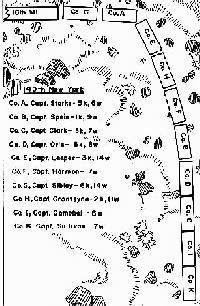
Deployment of the 140th New York on Little Round Top
Company, company commander and caualties
As to the other casualties among the 140th's commissioned officers, Starks will return to the regiment in the fall, but Sibley will be discharged for disability because of his wound. In all, 26 men are killed and 89 wounded. The 18 men listed as "missing" are lost to the regiment during the pursuit of Lee during his retreat and should not be counted as casualties in the battle itself. 25
There is one basic assumption that must be made in order to accept all or part of the preceding portrayal. While O'Rorke and his two lead companies descended the hill, one must assume that the rest of his officers exercised their best judgment in terms of what to do with the rest of the regiment. Out in front of the regiment, O'Rorke had effectively removed himself from a position from which he could control its movements and actions. Unless O'Rorke gave his plan to his field officers before he went down the slope (this seems extremely unlikely, and no suggestion of this shows up in any account), his subordinates had to make major tactical decisions. In a well-drilled regiment such as the 140th, this is not an outlandish thought. As noted before, Colonel Ernst had been in command of the regiment in combat. O'Rorke also held training schools and drill instruction for his officers while in camp. Often overlooked, these field and line officers deserve much credit for what happened on Little Round Top.
A retired Marine Corps colonel gives the following thoughts:
Even today, with all our fighting implements, Little Round Top would be a major effort to seize from an entrenched determined force.... [It is] correct to point out that folks of lesser grade are not given due credit. A good outfit, trained and well-led, does not need or depend on one man giving orders at the point of contact. That is what training is all about and the 140th received excellent training prior to Gettysburg. In my experience and personal knowledge, a lieutenant, a sergeant and a corporal saved the day. In this regard I believe that Lt. Col. Ernst is deserving of much more aplomb than history has seen fit to bestow.
While giving credit to Ernst and others, it would be a mistake to suggest that O'Rorke's performance on Little Round Top was sub-par. As with Joshua Chamberlain of the 20th Maine in the struggle to hold the opposite end of Vincent's line, O'Rorke faced a situation where he had to make a split-second decision. Like Chamberlain, O'Rorke's solution was unconventional. By exposing himself at the head of his column, he put his trust in his officers and the training he had given them. Both O'Rorke and Chamberlain were successful in holding their respective parts of the line. Unfortunately, O'Rorke was not successful in surviving the battle. With his death the Union army lost the potential future greatness of O'Rorke, and historians lost the chance to understand what his intentions and plans were on July 2, 1863, on Little Round Top.
Despite the active and important role the 140th New York played in the war's final chapters, the men considered their action at Gettysburg to be the brightest episode in the regiments history. Porter Farley wrote:
In a word, Gettysburg may have been the greatest disaster of the war, and might have turned the scales in favor of the rebellion. This may seem an extravagant statement, but every one who was there will corroborate the assertion that the 140th Regiment reached the crest of Little Round Top in the very nick of time.... We of the 140th are not so self-congratulatory as to think that the arrival of the Monitor in Hampton Roads just when and as she did, was a circumstance no more fortunate for the Union cause than was our timely arrival to fill the gap just when and as we did on Little Round Top at Gettysburg.... The service there must be regarded as the supreme event in its existence. 26